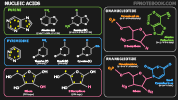Nucleic Acid, DNA, Deoxyribonucleic Acid, RNA, Ribonucleic Acid, Purine, Pyrimidine, Nucleoside, Nucleotide, DNA Replication, DNA Transcription, Genetic Transcription, Protein Biosynthesis, RNA Translation, Codon, Anticodon, Messenger RNA, Transfer RNA, DNA Polymerase, DNA Ligase, RNA Polymerase
- Definitions
- Pyrimidine
- Single ringed hexagonal structure forming base components of DNA and RNA (in addition to Purines)
- DNA is composed of the Pyrimidine based cytosine and thymine, and while RNA is composed of cytosine and uracil
- Purine
- Two ringed structures (Hexagon and Pentagon) forming base components of DNA and RNA (in addition to Pyrimidines)
- DNA and RNA are composed of the Purine based Adenine and Guanine
- Nucleoside
- Glycosylamine consisting of a base (Pyrimidine or Purine) combined with a sugar (ribose or deoxyribose)
- Ribose is the sugar moiety in RNA and 2-deoxyribose in DNA
- Nucleotide

- Nucleotides combine a Nucleoside with a phosphate moiety
- DNA and RNA are composed of Nucleotides strung together
- DNA is composed of the Pyrimidine Nucleotides cytosine and thymine and purine Nucleotides Adenine and Guanine
- RNA is composed of the Pyrimidine Nucleotides cytosine and uracil and purine Nucleotides Adenine and Guanine
- Nucleic Acid
- Linear sequence of Nucleotides to form either DNA or RNA
- Base Pairs
- Pyrimidine Nucleotides Thymine (T, in DNA) and Uracil (U, in RNA) pair with the purine Nucleotide Adenine (A)
- Pyrimidine Nucleotide Cytosine (C) pairs with the purine Nucleotide Guanine (G)
- Physiology
- DNA and RNA
- DNA Replication in Cell Division
- Prior to cell division, a complete copy of the genome in DNA must be created
- Pre-initiation complex forms
- DNA double helix is unwound into two, complementary single strands by the enzyme helicase
- Helicase creates a replication fork on the DNA strand, that unravels in both directions
- Topoisomerase (DNA gyrase) facilitates straight, less coiled DNA single strands
- Primase synthesizes short primer sequences of RNA on the DNA single strand
- Primer sequences mark starting sites for DNA polymerization
- DNA double helix is unwound into two, complementary single strands by the enzyme helicase
- Elongation
- DNA Polymerase
- Starts at a primer site, facilitating polymerization of each Nucleotide sequentially, forming a new DNA fragment
- Mismatched Nucleotides are hydrolyzed and removed by DNA Polymerase
- DNA Ligase
- Connects the DNA fragments ("Okazaki Fragments") synthesized by DNA Polymerase into a single DNA strand
- DNA Polymerase
- DNA Cleanup
- Endonucleases
- Hydrolyze Nucleotide connections at the start of a DNA fragment to be excised
- Allows for excision of defective DNA segments, both during replication, as well as general DNA housekeeping
- Exonucleases
- Hydolyze terminal connections of a DNA fragment to be excised
- Endonucleases
- Resources
- DNA Replication
- DNA Transcription to RNA
- Initiation
- Core Promoters are located near transcription starting points
- General Transcription Factors and enhancers trigger the start of transcription
- RNA Polymerase
- Begins transcribing the DNA at a promoter site, and reads until it reaches a stop sequence
- Facilitates polymerization of each Nucleotide sequentially, forming a new RNA fragment
- RNA Types
- Messenger RNA (mRNA)
- Primary template for Protein synthesis, to be translated by ribosomes
- Transfer RNA (tRNA)
- Three Nucleotide sequences (Anticodons) are each matched to a specific Amino Acid (see below)
- tRNA is assembled (with an Anticodon attached to an Amino Acid) with the enzyme Amino Acyl-tRNA synthetase
- Anticodons match the 3 Nucleotide codons on mRNA
- During translation at the ribosomes, tRNA attaches to corresponding mRNA, creating an Amino Acid chain (Protein)
- Ribosomal RNA
- Forms an important component of the ribosome
- Includes ribozymes (peptide bond catalysts)
- Messenger RNA (mRNA)
- Resources
- DNA Transcription
- Initiation
- RNA Translation to Protein
- mRNA is translated by Ribosomes into Protein
- Each codon (3 Nucleotide sequence) within mRNA is matched to an anti-codon of tRNA linked to an Amino Acid
- Twenty Amino Acids are each assigned at least 2 to 3 matching codons (61 codons out of 64 possible sequences)
- The 3 remaining codons (of 64 total) function as stop signals
- tRNA assembly (Anticodon with attached Amino Acid) is synthesized via enzyme Amino Acyl-tRNA synthetase (see above)
- Resources
- RNA Translation
- Physiology
- Nucleotides
-

- Purines (Adenine and Guanine)
- Purine synthesis via two pathways
- Salvage of already formed Purines combined with Phosphoribosyl Pyrophosphate (PRPP)
- Multistep synthesis from Glycine, Tetrahydrofolate, Glutamine, CO2, Aspartate
- Purine metabolism
- Urate formation, that is renally excreted
- Purine synthesis via two pathways
- Pyrimidines (Cytosine, Thymine, Uracil)
- Synthesis of other molecules from Nucleotides
- References
- Goldberg (2001) Biochemistry, Medmaster, Miami, p. 36-9